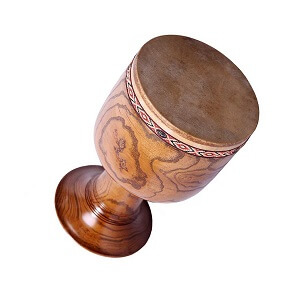Tombak
 The Tonbak (also called Zarb, the Persian goblet drum) and the Daf (the Kurdish frame drum) are the only national drums of Persia. Also the presence of goblet drums in Asia, North Africa and East Europe shows the importance of this class of drums. Unfortunately, the origin of the Tonbak is still in dispute. Etymologists say that the Pahlavi (Persian pre-Islamic language) name of the Tonbak is 'Dombalag', and it was known to be present in the Zourkhaneh (the Persian traditional gymnasium) so we know that it is ancient, pre-dating the Islamic period.
The Tonbak (also called Zarb, the Persian goblet drum) and the Daf (the Kurdish frame drum) are the only national drums of Persia. Also the presence of goblet drums in Asia, North Africa and East Europe shows the importance of this class of drums. Unfortunately, the origin of the Tonbak is still in dispute. Etymologists say that the Pahlavi (Persian pre-Islamic language) name of the Tonbak is 'Dombalag', and it was known to be present in the Zourkhaneh (the Persian traditional gymnasium) so we know that it is ancient, pre-dating the Islamic period.
Various names for the Tonbak, throughout its history, trace the application of this instrument in different parts of ancient Persia. For a lexical discussion please refer to the article section of the Tombak Network. There is a very good ancient manuscript (Kanz-al-Tohaf, by Hassan Kashani) on theoretical Old Persian music, in which, at the end of the book, the author tries to describe the methods of making the various musical instruments of his time. But unfortunately he has not included the drums (particularly the Tonbak) in his descriptions. Still, our information about the Tonbak and tonbak players of the Ghajar period is sufficient, thanks to two important books on the history of Persian art music ([KH] and [M]).
During the Pre-Islamic ages, the tombak was known as the dombalag. Today, the names that the tombak is known by (tonbak, donbak, dombak) are all derived from the term, dombalag. When it comes to the history of the tombak, much of it is in dispute since a lot of the historical accounts have not survived or were not published. It is known that the tombak is ancient through historical accounts and paintings that date this instrument back to hundreds and hundreds of years ago. For instance, there are 17th century paintings featuring tombak players.